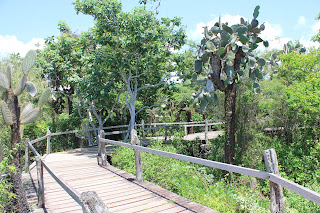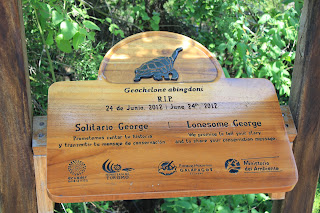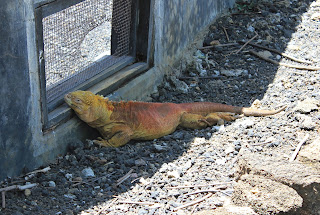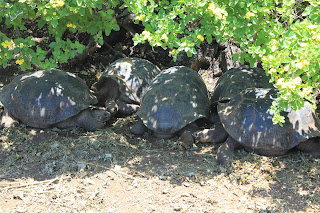The main attractions in the Galapagos, other than the
wildlife, revolve around the volcanic geology of the islands. On Santa Cruz there are lots of lava tunnels. One of the tunnels, Los Tuneles de Bellavista
(or Tuneles de Amor) is the second longest in South America – 2250m long. We decide to give it a go.
Perhaps it has been too long away from civilisation or
perhaps too long around overly relaxed people, but we were particularly
unprepared for our trip to the lava tunnels.
We leave Toodles early in the morning, chatting away to fellow cruiser
friends on the water taxi ride in. Once
we say goodbye to our friends, we realise we have forgotten the name of the
particular tunnels we want to go to. We
head to the internet café to Google it.
Now with the name of the place in hand, we manage to communicate where
we want to go to the taxi driver.
Half way to the tunnels, we realise we have no flashlight –
perhaps this might have been handy since we are visiting underground caves? We hope for the best and carry on.
We are dropped outside what looks like a residential house,
and in fact is. It is the house on the
property that boasts the entry to the lava tunnels, and therefore is able to
charge you for access.
The first man we meet is a bit ruffed up, with a smear of
mud down one side and cobwebs on his hard hat.
He greets us with a big smile and thankfully speaks English. He isn’t a tour guide, nor affiliated with
the tunnel, but is instead a geologist and the author of the Central and South
American Lava Tunnels book, which takes pride of place on the desktop. He just happened to be taking some friends
through the tunnel that morning. He
chats to us about the best way to go through the tunnel and what we might
see. The tunnel has two parts, one easy
and one hard. We decide to do both. We tell him we are without a flashlight and
he reassures us that the girl behind the desk will lend us one. Then he catches sight of our shoes….flip flops,
of course. He tentatively suggests that
we might want to go back for our tramping boots. We decide we will give it a go anyway.
With borrowed flashlight in hand, we venture through the
back garden and down the steps into the cave.
As we descend the steps, we can feel the cool air engulfing
us. It is very dark and very quiet. My
ears ring with the silence, reminding me of when I have returned home from a loud
concert. We are the only people in the
tunnel. We turn on our flashlight and
realise something that should have been obvious had we thought about it: the tunnel is damp. Beads of water hang from the ceiling, looking
as if they are glowing when we shine the torch on them, and drop into the pools
of water on the ground making a pleasant "drip, drip" sound.
Most of the pathway on the easy side of the
tunnel is flat, although we scramble over the odd pile of loose volcanic rock:
a particularly difficult task in slippery flip flops! We make it to the end of the tunnel and give
ourselves a pat on the back.
Now for the
more difficult side of the tunnel.
The difficult part of the tunnel is not advertised and not
signposted. We follow the directions our
author friend has given us, climbing over a log that seems strategically placed
to block the pathway. The entrance to
this part of the tunnel is not as easy: no steps in sight, but instead a crawl
down some mud and rocks. Inside the
tunnel there is no nice flat path, only piles of loose rock. We struggle through the first 500m or so, to
the first opening to the surface. This
part has taken us over 30 minutes. We
had been recommended to take the right hand tunnel from here, which leads to
the best parts of the lava caves. To get
down this side is a bit of a close call, requiring some crawling and resulting
in a few bumps on the head. As we
descend slowly further underground, I get more and more unhappy.
Perhaps this is the point to tell you that Gary’s worst fear
is falling into a lava river, and mine is being trapped underground. I can’t give you any particular explanation
for Gary’s fear, but mine stems from doing some extreme caving at a leadership
camp where we had to crawl on our stomachs for 20 metres, with only barely
enough room to lift your cheek off the ground before your head hit the roof.
While descending this part of the lava cave, exaggerated
thoughts begin to spin through my head:
Perhaps they blocked the pathway because the ceiling rocks are coming
loose? Perhaps the rock a centimetre from my head might fall at any
moment? Maybe the rocks behind us will
fall blocking our exit? And, who really
knows we are here? So I chicken out and
head back to the exit to the surface we had just passed. Gary decides to continue on. He is gone a while, but comes back after not
reaching the end. Apparently similar
thoughts had plagued him as he ventured further underground alone. Thinking about it logically, there really was
no risk of rocks falling. The geologist
who surveys tunnels and writes them up in a book had
literally just gone through the
tunnel. Surely he wouldn’t have
suggested we go through the tunnel if there had been any problems. But this wasn’t a comfort to us while
crawling a kilometre underground, over rocks, in the darkness, in slippery
jandals.
We exit the tunnel at this half way point. There is no path above ground. We weave our way through an overgrown banana
plantation, pulling apart spider webs with the end of the flashlight. We find our way to the main road and back to
the house to return the flashlight.
We had expected, being a tourist attraction, there would be
lots of taxis waiting to take us home.
But there isn’t, nor is anyone able to call one for us. We head back to
the main road and walk the few kilometres to the nearest town where we do find
a taxi.
Have we learned any lessons?
We’ll see….











































